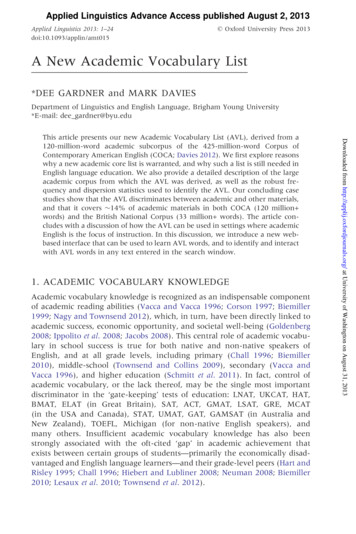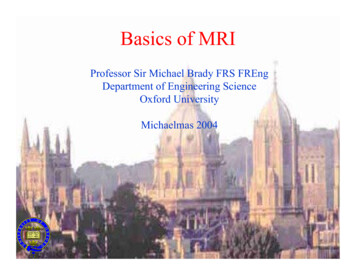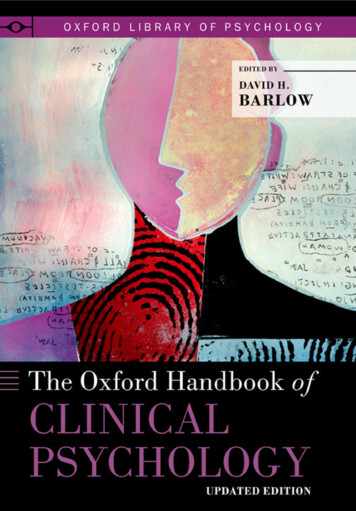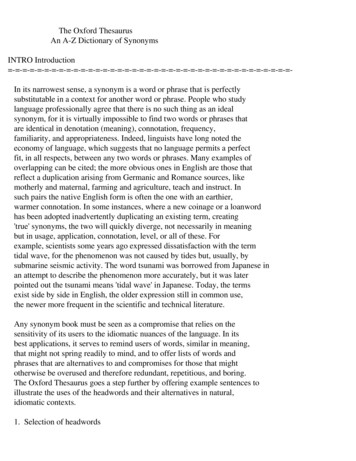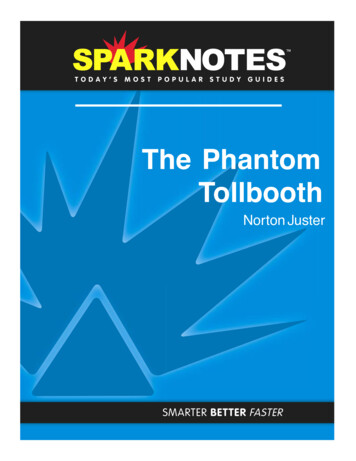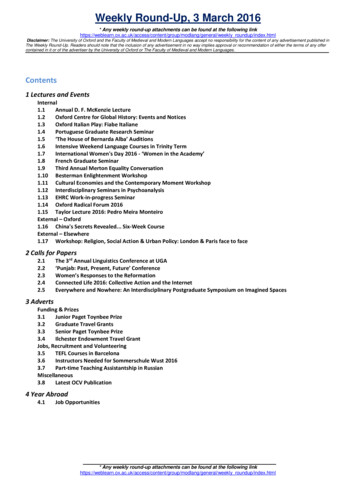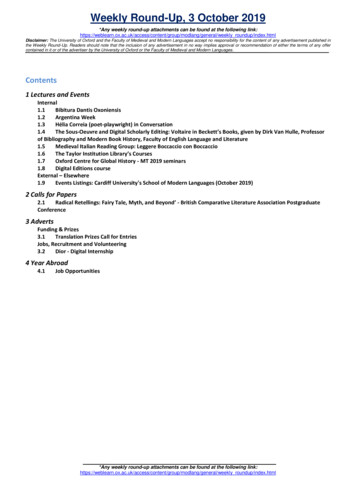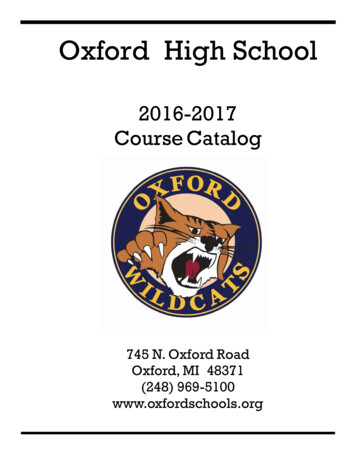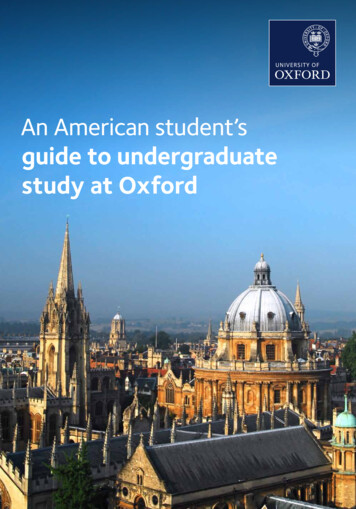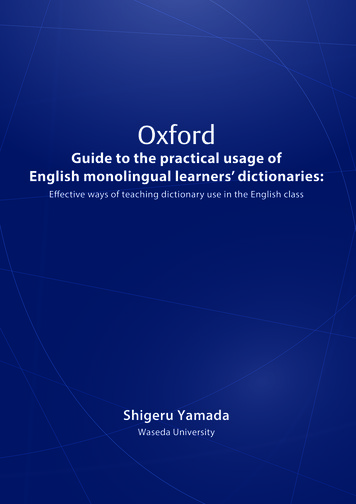
Transcription
OxfordGuide to the practical usage ofEnglish monolingual learners’ dictionaries:Effective ways of teaching dictionary use in the English classShigeru YamadaWaseda University
Oxford University PressGuide to the practical usage of English monolingual learners’ dictionaries:Effective ways of teaching dictionary use in the English classShigeru Yamada (Waseda University)Contents:Introduction1. Purpose and significance of using dictionaries . 12. Dictionary usage and how to teach it . 13. Dictionary types and characteristics . 13.1 Dictionary typology . 13.2 Two directions for dictionary searches . 23.3 English dictionaries for reception . 23.3.1 English monolingual dictionaries for native and non-native speakers . 23.3.2 English monolingual learners’ dictionaries and English-Japanese dictionaries . 33.4 English dictionaries for production . 43.4.1 Japanese-English dictionaries . 43.4.2 Thesauruses and synonym dictionaries . 53.4.3 Collocation dictionaries . 54. Important points when selecting English monolingual learners’ dictionaries . 55. Important points regarding the usage of English monolingual learners’dictionaries . 65.1 Seven-step dictionary look-up process . 65.2 Dictionary look-up for reception . 75.3 Dictionary look-up for production . 106. Activity ideas . 106.1 Introductory activities . 106.2 Activities for reception . 126.3 Activities for production . 136.4 Comprehensive activities . 14References . 17
IntroductionIntroductionVarious types of dictionaries exist throughout the world. For non-native speakers learning theEnglish language, English monolingual learners’ dictionaries play an important role. The first fullfledged dictionary in this field was the Idiomatic and Syntactic English Dictionary published by Kaitakusha Publishing in Japan in 1942 (edited by Hornby et al.), which later became the Oxford AdvancedLearner’s Dictionary (OALD). English monolingual learners’ dictionaries have developed amidst fiercecompetition among publishers and in a context influenced by the growing importance of English asa global language, the development of linguistics and lexicography, and technological progress. Itwould be reasonable to say that English monolingual learners’ dictionaries are the most advanced inall dictionary genres in terms of compilation methods, information quality, and presentation methods. These dictionaries are useful tools and resources for non-native speakers studying English. Todaymany English monolingual learners’ dictionaries are available online at no charge. In addition, handheld electronic dictionaries for advanced learners contain multiple dictionaries, and learners mayalso use applications on their smartphones. As electronic dictionaries can be freely searched, havingseveral paper dictionaries across a desk and constantly referring to them appears to be something ofthe remote past. Personal preferences exist with regard to dictionaries, but in my opinion, the usageof English monolingual learners’ dictionaries is a reliable way to improve English-language abilities.Why not use them? It is a good idea for non-native speakers to have English monolingual learners’dictionaries as one option on the desk or at the fingertip. In this guide, I will discuss dictionaries thatsupport learning activities of Japanese people in terms of the reception (reading and listening) andproduction (writing and speaking) of English with a special focus on receptive-type English monolingual learners’ dictionaries. Examples of specific activities will also be introduced. I hope that thisguide will prove useful for the better utilisation of dictionaries in classes and in individual study.* This is the English translation of the original version written in Japanese for the use by Japanese teachers of English. Although most parts are believed to be useful for internationalEFL readerships, it will be helpful for non-Japanese readers to replace “Japan” and the “Japanese language” with their country/region and native language, in order to make sense of thecontent (e.g., “English-Japanese dictionaries” correspond to “English-Spanish dictionaries” forSpanish speakers). However, there are inevitably several parts applicable only to Japanese andJapanese use. The below activities, for example, need to be tailored for the reader’s linguisticsituation:Looking up English words related to Japan (p.11)Looking up loan words from English (p.11)Comparing English definitions with Japanese translational equivalents (p.11)Translation of the entry of “obsession” (Pair and group work, p.15)
1. Purpose and significance of using dictionariesPurpose and significance ofusing dictionariesDictionaries are primarily tools for quick reference. However, when using a foreign-language dictionary, an element of learning is added to the goal of reference. It does not matter whether this isseen to be an added value, effect or end. English monolingual learners’ dictionaries conscientiouslyteach the meaning of words, grammar, pronunciation and culture, and also present models for output. In this sense, these dictionaries are too good to be used only for reference. Nowadays, websitesrapidly display the translations of words, and some may find the task of consulting a dictionary troublesome. However, dictionary consultation facilitates self-study. Using a dictionary presents a significant learning opportunity, as it increases knowledge, polishes one’s sense of language and enhancesthe power of expression. It also presents an opportunity for unexpected discoveries. Moreover, theuse of multiple dictionaries expands learners’ perspective even more and further deepens their understanding. In order to fully enjoy the act of consulting a dictionary and maximise its benefits, it isnecessary to learn about the different types of dictionaries and how to use them.2. Dictionary usage and how to teach itDictionary usage andhow to teach itWhat does it mean to be able to use a dictionary? Although people often consult a dictionaryin a casual manner, in reality this demands a complex and advanced intellectual process. Let us refer to Figure 1 and consider the two abilities needed to use a dictionary in relation to the teachingof those abilities. To use an English monolingual learner’s dictionary, for example, a foreign studentis required to have general linguistic ability (English) and dictionary-specific ability. The dictionary-specific ability can be divided into static knowledge (familiarity with kinds of dictionaries andtheir functions) and dynamic knowledge (use of practical dictionary consultation methods). Thesetwo types of knowledge apply before and after the dictionary is opened, respectively. The dynamicknowledge can be subdivided into “general” and “specific”, depending upon the applicability to all (ormost) dictionaries or only certain ones. The general linguistic ability should be developed in generallanguage lessons, while the dictionary-specific ability through the teaching of dictionary use. Theteaching component concerned with static knowledge is referred to as guidance; that with dynamicknowledge as instruction (Yamada 2001: 116-117).General linguisticabilityDictionary-specificabilityGeneral ralSpecificGuidance Teaching ofdictionaryInstruction useFigure 1. Two abilities entailed in dictionary use and teaching thereof (Yamada 2001: 125)Let us now examine in greater detail static and dynamic knowledge in the context of dictionary use.3. Dictionary types and characteristicsDictionary types andcharacteristics3.1 Dictionary typologyToday, a great variety of English dictionaries exist, but their classification is not straightforward. Toselect and use dictionaries appropriately, it is valuable to recognise the different types of dictionariesthat exist and their classification. They may be classified according to the following categories (notethat these classifications are not exhaustive and, in some cases, they represent trends as opposed tocategories): scale and scope (general or specialised; linguistic or encyclopaedic; diachronic or synchronic); format (alphabetical or thematic); principle (historical, frequency); approach (descriptive or1
Dictionary types andcharacteristicsprescriptive); information category; number of languages; medium (print or electronic); use (receptiveor productive); target audience (native or non-native speakers); search method (alphabetical order,index); compilation method (corpus usage, translation); publication objective (academic, commercial) (Koike et al. 2003: 652).3.2 Two directions for dictionary searchesHenceforth, I will present a general overview of useful English dictionaries for Japanese learners.These dictionaries can be divided into receptive and productive types. Let us consider the two goalsof dictionary usage. First, for example, when people encounter an unknown word when reading anEnglish-language newspaper, they refer to an English-Japanese dictionary. Second, if they do not knowthe proper English word to express a certain meaning when writing an e-mail in English, they refer to aJapanese-English dictionary. The figure below thus depicts the two directions of dictionary searches:Receptive typeFORM MEANING(Spelling, etc.)Productive typeWhen encountering an unfamiliar word in an English-language newspaper, looking up themeaning of the word in an English-Japanese dictionary (FORM MEANING) involves a receptivesearch. In contrast, a productive search relates to the use of a Japanese-English dictionary to find outhow to express a certain Japanese meaning in English (MEANING FORM) when writing an e-mailin English.The following English dictionaries can be used by Japanese people for reception and production:Reception: English-Japanese dictionaries and English-English dictionaries (for native andnon-native speakers)Production: J apanese-English dictionaries, thesauruses, synonym dictionaries and collocationdictionariesThe headwords in English-Japanese and English-English dictionaries are arranged in alphabetical order. They are primarily dictionaries used for receptive purposes, although this does not excludetheir usage for production. A special knowledge about synonyms, for example, is required whenusing these dictionaries for productive purposes. English-Japanese and English monolingual learners’ dictionaries also include information relevant for production such as grammar, collocation, synonyms, common errors and so forth.3.3 English dictionaries for receptionThis guide will now explore the characteristics of dictionaries that may be used by Japanesepeople for reception, by comparing English monolingual learners’ dictionaries with dictionaries intended for native speakers and then English–Japanese dictionaries.3.3.1 English monolingual dictionaries for native and non-native speakersThere are two types of English-English dictionaries: for native and non-native speakers. The former type is the equivalent of Japanese-language dictionaries for Japanese speakers. On the otherhand, English monolingual learners’ dictionaries target non-native speakers learning English. Let uscompare the definition of “dog” in the Oxford Dictionary of English (for native speakers), and the OALD,(for non-native learners):a domesticated carnivorous mammal that typically has a long snout, an acute sense of smell,non-retractile claws, and a barking, howling, or whining voice. Oxford Dictionary of
Japanese-English dictionary. The figure below thus depicts the two directions of dictionary searches: When encountering an unfamiliar word in an English-language newspaper, looking up the meaning of the word in an English-Japanese dictionary (FORM MEANING) involves a receptive search. In contrast, a productive search relates to the use of a Japanese-English dictionary to find out how to .

